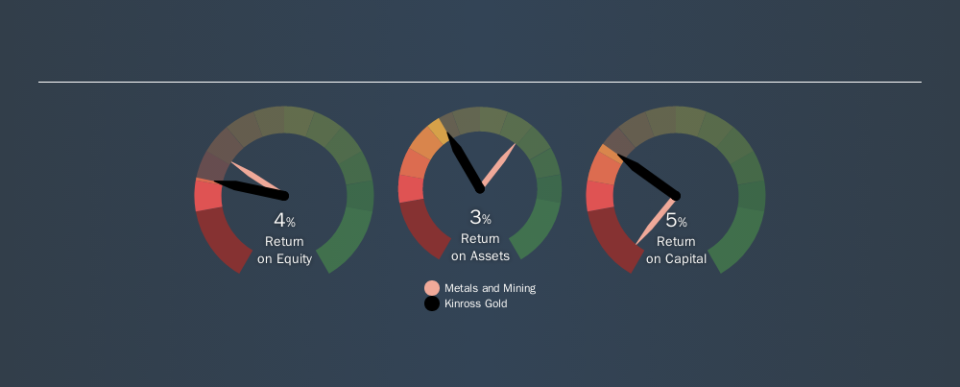Are Kinross Gold Corporation’s (TSE:K) High Returns Really That Great?

Today we'll look at Kinross Gold Corporation (TSE:K) and reflect on its potential as an investment. To be precise, we'll consider its Return On Capital Employed (ROCE), as that will inform our view of the quality of the business.
First up, we'll look at what ROCE is and how we calculate it. Then we'll compare its ROCE to similar companies. Finally, we'll look at how its current liabilities affect its ROCE.
Understanding Return On Capital Employed (ROCE)
ROCE is a metric for evaluating how much pre-tax income (in percentage terms) a company earns on the capital invested in its business. Generally speaking a higher ROCE is better. In brief, it is a useful tool, but it is not without drawbacks. Author Edwin Whiting says to be careful when comparing the ROCE of different businesses, since 'No two businesses are exactly alike.
How Do You Calculate Return On Capital Employed?
The formula for calculating the return on capital employed is:
Return on Capital Employed = Earnings Before Interest and Tax (EBIT) ÷ (Total Assets - Current Liabilities)
Or for Kinross Gold:
0.055 = US$429m ÷ (US$8.4b - US$599m) (Based on the trailing twelve months to September 2019.)
So, Kinross Gold has an ROCE of 5.5%.
See our latest analysis for Kinross Gold
Does Kinross Gold Have A Good ROCE?
When making comparisons between similar businesses, investors may find ROCE useful. In our analysis, Kinross Gold's ROCE is meaningfully higher than the 3.1% average in the Metals and Mining industry. I think that's good to see, since it implies the company is better than other companies at making the most of its capital. Setting aside the industry comparison for now, Kinross Gold's ROCE is mediocre in absolute terms, considering the risk of investing in stocks versus the safety of a bank account. It is possible that there are more rewarding investments out there.
Kinross Gold delivered an ROCE of 5.5%, which is better than 3 years ago, as was making losses back then. This makes us wonder if the company is improving. You can click on the image below to see (in greater detail) how Kinross Gold's past growth compares to other companies.
When considering ROCE, bear in mind that it reflects the past and does not necessarily predict the future. ROCE can be misleading for companies in cyclical industries, with returns looking impressive during the boom times, but very weak during the busts. ROCE is only a point-in-time measure. We note Kinross Gold could be considered a cyclical business. Since the future is so important for investors, you should check out our free report on analyst forecasts for Kinross Gold.
What Are Current Liabilities, And How Do They Affect Kinross Gold's ROCE?
Current liabilities include invoices, such as supplier payments, short-term debt, or a tax bill, that need to be paid within 12 months. Due to the way the ROCE equation works, having large bills due in the near term can make it look as though a company has less capital employed, and thus a higher ROCE than usual. To counter this, investors can check if a company has high current liabilities relative to total assets.
Kinross Gold has total assets of US$8.4b and current liabilities of US$599m. Therefore its current liabilities are equivalent to approximately 7.1% of its total assets. Kinross Gold has a low level of current liabilities, which have a minimal impact on its uninspiring ROCE.
Our Take On Kinross Gold's ROCE
Kinross Gold looks like an ok business, but on this analysis it is not at the top of our buy list. You might be able to find a better investment than Kinross Gold. If you want a selection of possible winners, check out this free list of interesting companies that trade on a P/E below 20 (but have proven they can grow earnings).
If you are like me, then you will not want to miss this free list of growing companies that insiders are buying.
We aim to bring you long-term focused research analysis driven by fundamental data. Note that our analysis may not factor in the latest price-sensitive company announcements or qualitative material.
If you spot an error that warrants correction, please contact the editor at editorial-team@simplywallst.com. This article by Simply Wall St is general in nature. It does not constitute a recommendation to buy or sell any stock, and does not take account of your objectives, or your financial situation. Simply Wall St has no position in the stocks mentioned. Thank you for reading.

 Yahoo Finance
Yahoo Finance 
